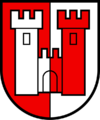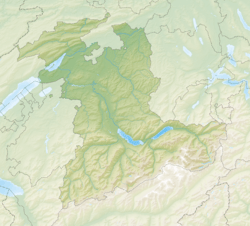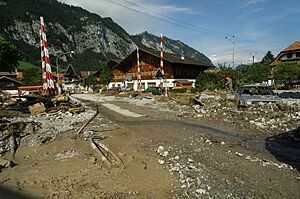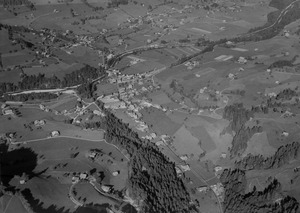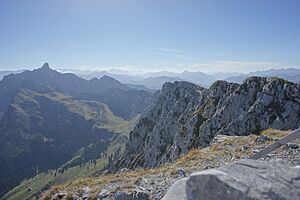Diemtigen facts for kids
Quick facts for kids
Diemtigen
|
||
|---|---|---|
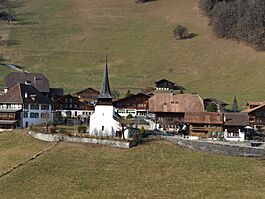 |
||
|
||
| Country | Switzerland | |
| Canton | Bern | |
| District | Frutigen-Niedersimmental | |
| Area | ||
| • Total | 129.94 km2 (50.17 sq mi) | |
| Elevation | 609 m (1,998 ft) | |
| Population
(Dec 2020 )
|
||
| • Total | 2,253 | |
| • Density | 17.339/km2 (44.907/sq mi) | |
| Postal code |
3753
|
|
| Surrounded by | Adelboden, Boltigen, Därstetten, Erlenbach im Simmental, Frutigen, Oberwil im Simmental, Reichenbach im Kandertal, Sankt Stephan, Wimmis, Zweisimmen | |
Diemtigen is a lovely village and a municipality in the canton of Bern, Switzerland. It's found at the northern end of the Diemtigtal valley. The village sits high up on a flat area, west of the Chirel creek.
In 1986, Diemtigen won a special award called the Wakker Prize. This prize is given for keeping old buildings and the town's look beautiful.
Contents
History of Diemtigen
Diemtigen was first written about in the year 1257. But people lived in the area much, much earlier! They were here during the Bronze Age, which was thousands of years ago. Some even think people were here during the Mesolithic Era, an even older time.
By the High Middle Ages (around 1000 to 1500 AD), people lived here all the time. They even built castles on the hills above the valleys. We don't know much about the ruins of Kronegg Castle or Grafenstein Castle.
The third castle, Hasenburg Castle, was mentioned in 1257. It was once home to a noble family called the Freiherr von Strättligen. Later, the city of Bern bought the castle and its lands in 1439.
The people of Diemtigen valley were given special laws and rights in 1361 and 1393. These laws were written down clearly in 1649.
Starting in the 1400s, mountain passes opened up. This helped people trade with nearby areas like Adelboden and Zweisimmen. By the 1500s, villagers bought grain from lower lands. They also raised cattle in the high mountain meadows and sold them.
Life was sometimes hard due to little farmland. Many people left the valley to find work. Before the 1800s, some became soldiers for hire (mercenaries). After 1800, many moved to places like North America or Germany.
In 1798, French armies came to Switzerland. Diemtigen became part of a new area called the Canton of Oberland. But in 1803, it went back to being part of the Canton of Bern.
In the 1700s, people started building spas around natural mineral springs. Two famous ones were Rothbad Horben and Kurhaus Grimmialp. These helped bring visitors to the village.
When the Simmental road and the Spiez-Zweisimmen railroad were built in 1897, it was a big change. More businesses came, and even more tourists visited. The main train station was built in Oey. This village grew and became the center of Diemtigen. In 1963, a hotel and sports center were built to attract more tourists. Today, tourism is very important for Diemtigen's economy. But farming is still a big part of life. Diemtigen has more seasonal mountain pastures than any other Swiss municipality!
The village church, St. Nicholas, was first mentioned in 1314. It was made bigger in 1490. In 1527, the valley changed to the Protestant faith. The church then became the main church for the Diemtigen area.
Geography of Diemtigen
Diemtigen covers about 130 square kilometers. A large part of this land, almost half (48%), is used for farming. About 30% is covered by forests. A small part (1.7%) has buildings or roads. Rivers and lakes make up 0.5%. The rest (19.4%) is land that can't be used for farming or building, like rocky areas.
Most of the forests are very dense. A lot of the farmland is used for mountain pastures where animals graze. All the water in Diemtigen is flowing water, like rivers and streams.
The municipality of Diemtigen is located in the Diemtig valley. It also includes several nearby valleys. It has different settlements like Oey, Diemtigen, Bächlen, Horben, Riedern, Entschwil, Zwischenflüh, and Schwenden. There are also many small groups of houses high up in the mountains and forests.
Coat of Arms
The blazon of Diemtigen's coat of arms shows a castle. It is split down the middle. One side is red with a white castle, and the other side is white with a red castle.
People of Diemtigen
Diemtigen has a population of about 2,138 people (as of December 2011). Most people in Diemtigen speak German. A small number speak Albanian or Serbo-Croatian.
In 2011, about 23% of the people were children and teenagers (0–19 years old). About 58% were adults (20–64 years old). And about 19% were seniors (over 64 years old).
The population of Diemtigen has stayed quite steady over the years. You can see how the number of people has changed in the chart below:

Wakker Prize Award
The Wakker Prize is a special award given every year in Switzerland. The Swiss Heritage Society gives it to a town that does a great job of keeping its old buildings and history safe.
In 1986, Diemtigen won this prize. They won because they had a good plan to protect their beautiful area from too much new building. Even though the municipality is spread out, they managed to create large protected areas. This helped keep the natural beauty and old buildings safe.
Important Heritage Sites
Some buildings in Diemtigen are very important to Switzerland's history. The farm house in Oey at Sälbezen 714 and the farm house at Trogmatte 32 are listed as national heritage sites. This means they are very important and protected. The whole village of Diemtigen is also part of the Inventory of Swiss Heritage Sites.
Diemtigen's Economy
In Diemtigen, many people work in different jobs.
- The primary sector involves farming and forestry. Many people work in agriculture, especially with the many alpine pastures.
- The secondary sector includes jobs like manufacturing and construction.
- The tertiary sector covers services. This includes shops, restaurants, hotels, transportation, and education. Tourism is a big part of this sector.
Many people who live in Diemtigen also work there. Others travel to nearby towns for their jobs. Most people use a private car to get to work.
Religion in Diemtigen
Most people in Diemtigen belong to the Swiss Reformed Church. A smaller number are Roman Catholic. There are also people who belong to other Christian churches or other religions. Some people do not belong to any church.
Transportation
Diemtigen is on the Spiez–Zweisimmen train line. You can catch trains at the Wimmis and Burgholz railway stations. This makes it easy to travel to and from Diemtigen.
Education in Diemtigen
In Diemtigen, many people have finished high school. Some have also gone on to higher education, like university.
The school system in the Canton of Bern works like this:
- One year of non-required Kindergarten.
- Six years of Primary school.
- Three years of required lower Secondary school. Students are grouped by their abilities.
- After lower Secondary, students can continue their schooling or start an apprenticeship to learn a trade.
During the 2011-2012 school year, about 259 students went to school in Diemtigen. There were classes for kindergarten, primary school, and lower secondary school. Most of these students lived in Diemtigen. Some students came from other towns to go to school here.
See also
 In Spanish: Diemtigen para niños
In Spanish: Diemtigen para niños


